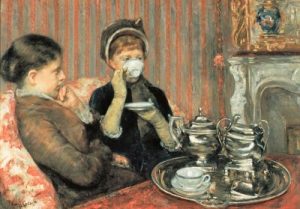From the archives: how my love of silver played out on the page!
I love silver. In all its guises. From silver cuffs and statement rings to sugar bowls and tea pots, the lure of a finely wrought piece of silver is irresistible. The hours I’ve spent in the silver hall at the Victoria & Albert museum gliding from one stunning display to the next, have given me an appreciation for silver as art, as utilitarian, and as historical record.
But, as a child, silver meant only one thing. We were eating in the dining room, and all the knives, forks and spoons had to be polished before company arrived. These days my flatware spends more time in the drawer than it does on the table, but not my silver candlesticks.
They are a thing of beauty.
Nothing is more elegant, or flattering, than basking in the soft glow of candlelight. Or more romantic. But before the advent of electricity and gas lighting, candles had a far more practical use, as did silver. Its reflective qualities made life, upstairs at any rate, a little easier and a whole lot brighter.
And there was the beginning of the story.
A single 18th century antique candlestick, rumored to be part of a much larger collection once belonging to King George II, has come on the market. Attracting our modern-day silver expert Samantha Redfern and her boss, Chas Porter, who for very different reasons, are both desperate to own it.
The candlestick was in superb condition.
Just under nine inches in height with a circular base, swirling shell motifs rising up its stem and a petal-shaped lip surrounding the socket. In a London sale, he would expect it to sell for another five hundred pounds. At least. A pair wouldn’t just double the price, it would triple it.
The candlestick’s monetary value has little to do with the story. It’s all about history, Chas’ and Sam’s, and how a single candlestick can change everything.
When Chas asks Sam about her interest in silver i n Chapter Two of Outbid by the Boss, her passion bubbles to the surface. She reveals more than she knows, about herself, her childhood and her family.
n Chapter Two of Outbid by the Boss, her passion bubbles to the surface. She reveals more than she knows, about herself, her childhood and her family.
…“I saw a painting when I was a young girl…called Five O’Clock Tea. It was only a picture in a book…about women silversmiths,” she blushed slightly. “Two young Victorian women sitting on a chintz sofa. There’s a silver tea service arranged on the table in front of them. One wears a hat and gloves and sips from a delicate porcelain cup. She’s the visitor. They’re just friends having tea, yet it was so…captivating.”
Enchanted, Chas watched the memories play across Sam’s face. She really was beautiful, and so much more real to him than she had ever been before.
She must have sensed he was looking at her. “I guess I was hooked.”
“On silver?” asked Chas.
Sam laughed. “Tea parties. My grandmother was a good sport.”
The painting Sam refers to is by Mary Cassatt, an American artist who lived and worked for much of her life in Paris. And the book Sam refers to is on my shelf. Published by the National Museum of Women in the Arts, it catalogues the museum’s collection of works by women silversmiths from 1685 to 1845.
“Businesswomen,” Philippa Glanville writes in the book’s opening chapter, “are not 20th-century phenomena.” Nor was their contribution to the silver industry. They were active business partners, owners and artisans making beautiful and functional objects from buttons and christening cups, to jewellery and candlesticks.
The threads of history continue to intrigue and inspire no matter what I write.
Outbid by the Boss is by Anne Stephenson & Susan Brown writing as Stephanie Browning.
